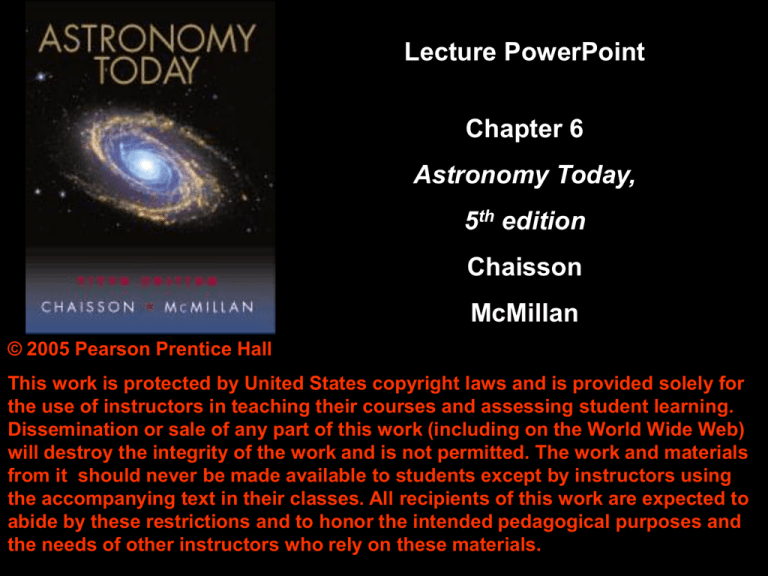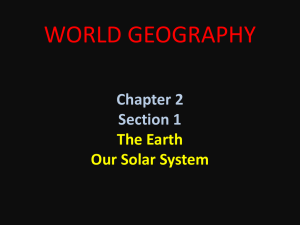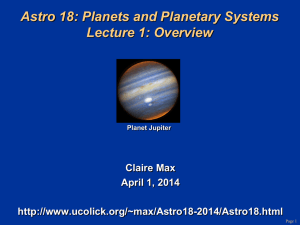
Lecture PowerPoint
Chapter 6
Astronomy Today,
5th edition
Chaisson
McMillan
© 2005 Pearson Prentice Hall
This work is protected by United States copyright laws and is provided solely for
the use of instructors in teaching their courses and assessing student learning.
Dissemination or sale of any part of this work (including on the World Wide Web)
will destroy the integrity of the work and is not permitted. The work and materials
from it should never be made available to students except by instructors using
the accompanying text in their classes. All recipients of this work are expected to
abide by these restrictions and to honor the intended pedagogical purposes and
the needs of other instructors who rely on these materials.
Chapter 6
The Solar System
Learning Goals
• What is comparative planetology?
• Describe the scale & structure of our solar
sytem
• Summarize the basic differences between the
terrestrial & jovian planets
• Identify & describe the major non-planetary
components of our solar system
• Describe some important solar system
exploration spacecraft missions
• Cosmogony – theories of solar system
formation
Units of Chapter 6
An Inventory of the Solar System
Planetary Properties
Computing Planetary Properties
The Overall Layout of the Solar System
Terrestrial, Jovian & Dwarf Planets
Interplanetary Debris (asteroids, comets &
meteors)
Units of Chapter 6, cont.
Spacecraft Exploration of the Solar System
Gravitational “Slingshots”
How Did the Solar System Form?
The Concept of Angular Momentum
6.1 An Inventory of the Solar System
Early astronomers knew the Moon, stars,
Mercury, Venus, Mars, Jupiter, Saturn, comets,
and meteors
Now known: Solar system has 166 moons, one
star, eight planets (added Uranus & Neptune),
many objects in the new class called dwarf
planets (Pluto, Ceres, Eris, …), asteroids,
comets, and meteoroids
6.2 Planetary Properties
63
60
13
6.2 Planetary Properties
• Distance from Sun known by Kepler’s laws
• Orbital period can be observed
• Radius known from angular size
• Masses from Newton’s laws
• Rotation period from observations
• Density can be calculated knowing radius and
mass
6.3 The Overall Layout of the Solar System
All orbits paths are close to the ecliptic plane
Pluto’s orbit does not (17° tilt)
6.4 Terrestrial and Jovian Planets
Relative sizes of the Sun & Planets
It would take 109
Earths to span the
Sun!
6.4 Terrestrial and Jovian Planets
Terrestrial planets:
Mercury, Venus, Earth,
Mars
Jovian planets:
Jupiter, Saturn, Uranus,
Neptune
Pluto is neither but a
new class called the
Dwarf planets
6.4 Terrestrial and Jovian Planets
Differences (Comparative Planetology)
between the terrestrial planets:
• Atmospheres and surface conditions are very
dissimilar
• Only Earth has oxygen in atmosphere and liquid
water on surface
• Earth and Mars rotate at about the same rate; Venus
and Mercury are much slower, and Venus rotates in the
opposite direction
• Earth and Mars have moons; Mercury and Venus
don’t
• Earth and Mercury have magnetic fields; Venus and
Mars don’t
6.5 Interplanetary Debris
Asteroids and meteoroids have rocky
composition; asteroids are bigger
Asteroid
is 34 km long:
6.5 Interplanetary Debris
Comets are icy, with some rocky parts.
ion tail
Comet Hale–Bopp
(1997)
dust tail
6.6 Spacecraft Exploration of the
Solar System
Mariner 10: flew by
Mercury, 1974–75
MESSENGER: it’s there
now!
Messenger
Mariner 10
6.6 Spacecraft Exploration of the
Solar System
Soviet Venera probes landed on Venus from
1970–1978:
6.6 Spacecraft Exploration of the
Solar System
Viking landers arrived at Mars in 1976:
6.6 Spacecraft Exploration of the
Solar System
Typical orbital path to Mars:
Spacecraft Exploration of the Solar System
The Sojourner Rover was deployed on Mars in
1997 as part of the Pathfinder Mission
6.6 Spacecraft Exploration of the
Solar System
Pioneer 10 & 11 and Voyager 1 & 2 flew through
the outer solar system. This is Voyager:
6.6 Spacecraft Exploration of the
Solar System
The Cassini mission is now orbiting around
Saturn, the ring system and its many moons; it
used many gravity assists to get there:
6.6 Spacecraft Exploration of the Solar System
Gravitational “slingshots” can change the
trajectories of spacecraft, and also accelerate them:
6.7 How Did the Solar System Form?
Nebular contraction:
Cloud of gas and dust contracts due to gravity;
conservation of angular momentum means it spins
faster and faster as it contracts
6.7 How Did the Solar System Form?
Condensation theory:
Interstellar dust grains
help cool cloud, and act as
condensation nuclei
6.7 How Did the Solar System Form?
Conservation of angular momentum says that
product of radius and rotation rate must be
constant:
L = mvr
Lbefore = Lafter
m1 v1r1 = m2 v2r2
Think ice skaters, divers
& gymnasts
6.7 How Did the Solar System Form?
Temperature in nebular cloud determines where
various materials condense out:
Summary of Chapter 6
• Solar system consists of Sun and everything
orbiting it
• Asteroids are rocky, and most orbit between
orbits of Mars and Jupiter
• Comets are icy, and are believed to have
formed early in the solar system’s life
• Major planets orbit Sun in same sense, and all
but Venus rotate in that sense as well
• Planetary orbits lie almost in the same plane
Summary of Chapter 6, cont.
• Four inner planets – terrestrial planets – are
rocky, small, and dense
• Four outer planets – jovian planets – (omitting
Pluto) are gaseous and large
• Nebular theory of solar system formation:
cloud of gas and dust gradually collapsed under
its own gravity, spinning faster as it shrank
• Condensation theory says dust grains acted as
condensation nuclei, beginning formation of
larger objects










